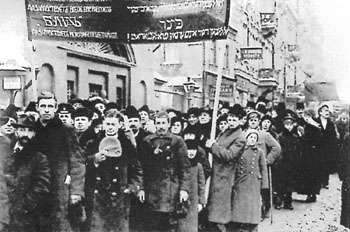Moisei Rafes
| Moisei Grigorevich Rafes Моисей Григорьевич Рафес | |
|---|---|
| General Controller | |
|
In office July 13, 1917 – August 14, 1917 | |
| President |
Mykhailo Hrushevsky (speaker of Central Rada) |
| Preceded by | position created |
| Succeeded by | Aleksandr Zarubin |
| Personal details | |
| Born |
1883 Vilno, Russian Empire |
| Died |
1942 (aged 59) GULAG, Komi ASSR, Soviet Union |
| Political party |
Jewish Bund (1910) RSDLP(b) (1907) |
| Occupation | Politician |
| Part of a series on the |
| Jewish Labour Bund |
|---|
 |
| 1890s to World War I |
| Interwar years and World War II |
| After 1945 |
|
| People |
| Press |
| Associated organisations |
| Splinter groups |
|
| Categories |
|
Moisei (Moishe) Grigorevich Rafes (Russian: Моше Рафес) (b. 1883, d. 1942) was a prominent Jewish politician of the Ukrainian People's Republic as the Bundist representative. After 1919 an official of the Bolshevik Party until the victory of Joseph Stalin, when he was imprisoned.[1]
Rafes was a member of the 1917 Russian Constituent Assembly[2] and also of the Central Council of Ukraine, the Petrograd Soviet, headed Jewish Bund in Kiev. In Kiev Rafes became a member of the Regional Committee in Protection of Revolution in Ukraine and served as the General Controller of the General Secretariat of Ukraine.[3] He was succeeded at this post by another Bundist, Aleksandr Zolotarev.
When tensions within the Bund heightened, due to the pro-Bolshevik leaning of a part of the leadership, Moisei Rafes was the leader of the centrist wing of the Bund, while Mikhail Liber and Benjamin Kheifetz led the rightists.[4]
However, Rafes led the scissionist Kombund group in Kiev in February 1919, later joined by similar groups in Yekaterinoslav, Kharkov and Poltava, but the Kombund lasted only till May 1919, when it merged into the Ukrainian Communist Union, 'Komfarband'. These moves were apparently motivated by the large-scale pogroms committed by all the armies present in Ukraine at the time, except the Red Army. After the refusal of the Soviet authorities to authorize the formation of a distinct Jewish Communist Party, Rafes, like other former Bundists Esther Frumkin, Alexander Chemerinsky and Rakhmiel Veinshtain, finally joined the upper echelons of the Yevsektsiya, the Jewish section of the Soviet Communist party (CPSU).[5]
Moisei Rafes was at the head of the artistic section of Sovkino and a member of the Sovkino board in the late 1920s and through 1930.[6]
Sources
- ↑ Lazić, Branko M.; Drachkovitch, Milorad M. (1986). Biographical dictionary of the Comintern. Hoover Press. p. 532. ISBN 978-0-8179-8401-4.
- ↑ Bunyan, James; Fisher, Harold Henry (1934). The Bolshevik revolution, 1917-1918: documents and materials. Stanford University Press. p. 735. ISBN 978-0-8047-0344-4.
- ↑ General Secretariat of the Central Rada
- ↑ Borys, Jurij (1980). The Sovietization of Ukraine, 1917-1923: the Communist doctrine and practice of national self-determination. Canadian Institute of Ukrainian Studies. p. 488. ISBN 978-0-920862-03-2.
- ↑ Levin, Nora (1990). The Jews in the Soviet Union Since 1917: Paradox of Survival. New York: New York University Press. ISBN 978-0-8147-5051-3. Retrieved 2009-11-10.
- ↑ Miller, Jamie (November 2006). "The purges of Soviet cinema, 1929–38". Studies in Russian and Soviet Cinema. I (1): 5–26. doi:10.1386/srsc.1.1.5_1. ISSN 1750-3132.